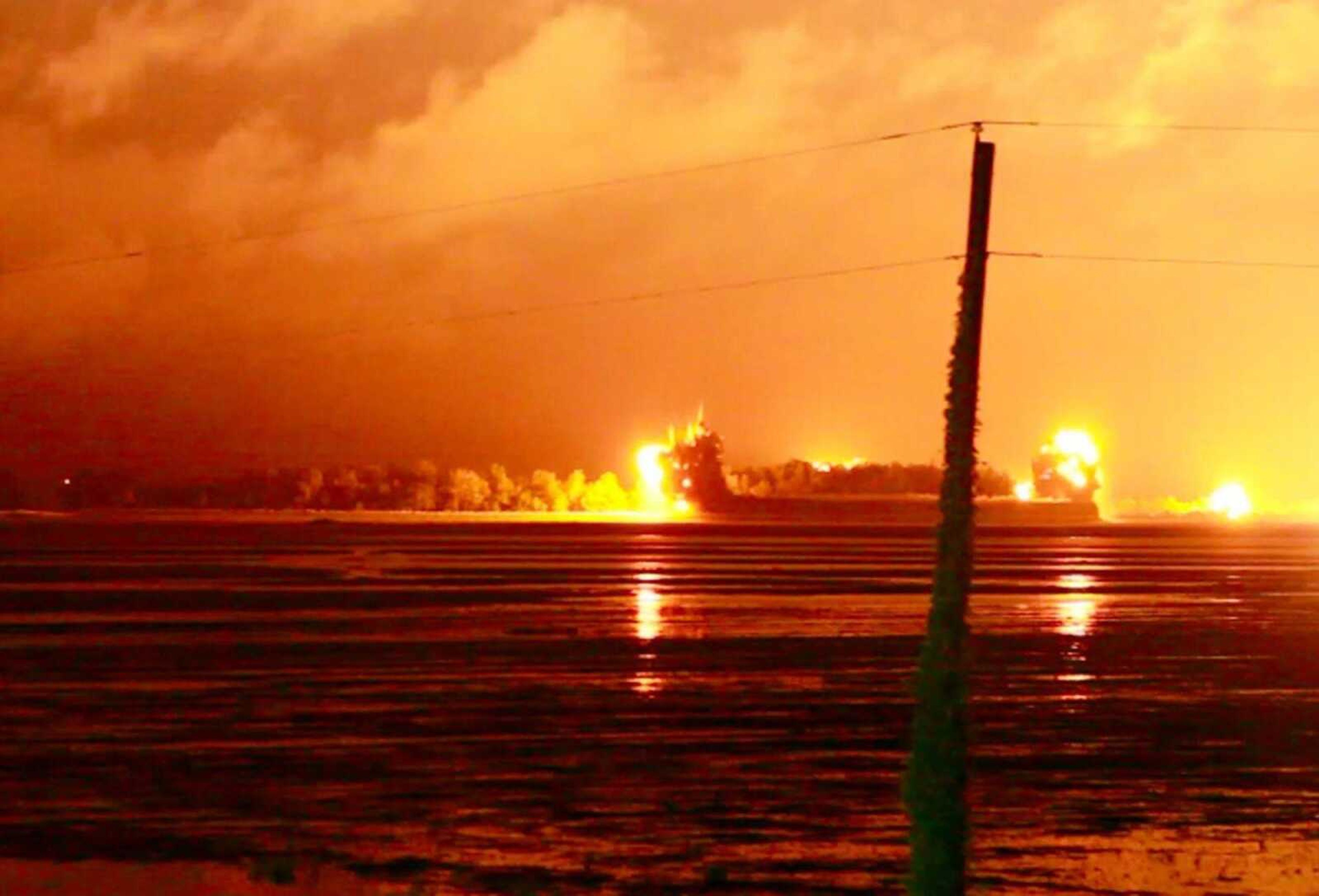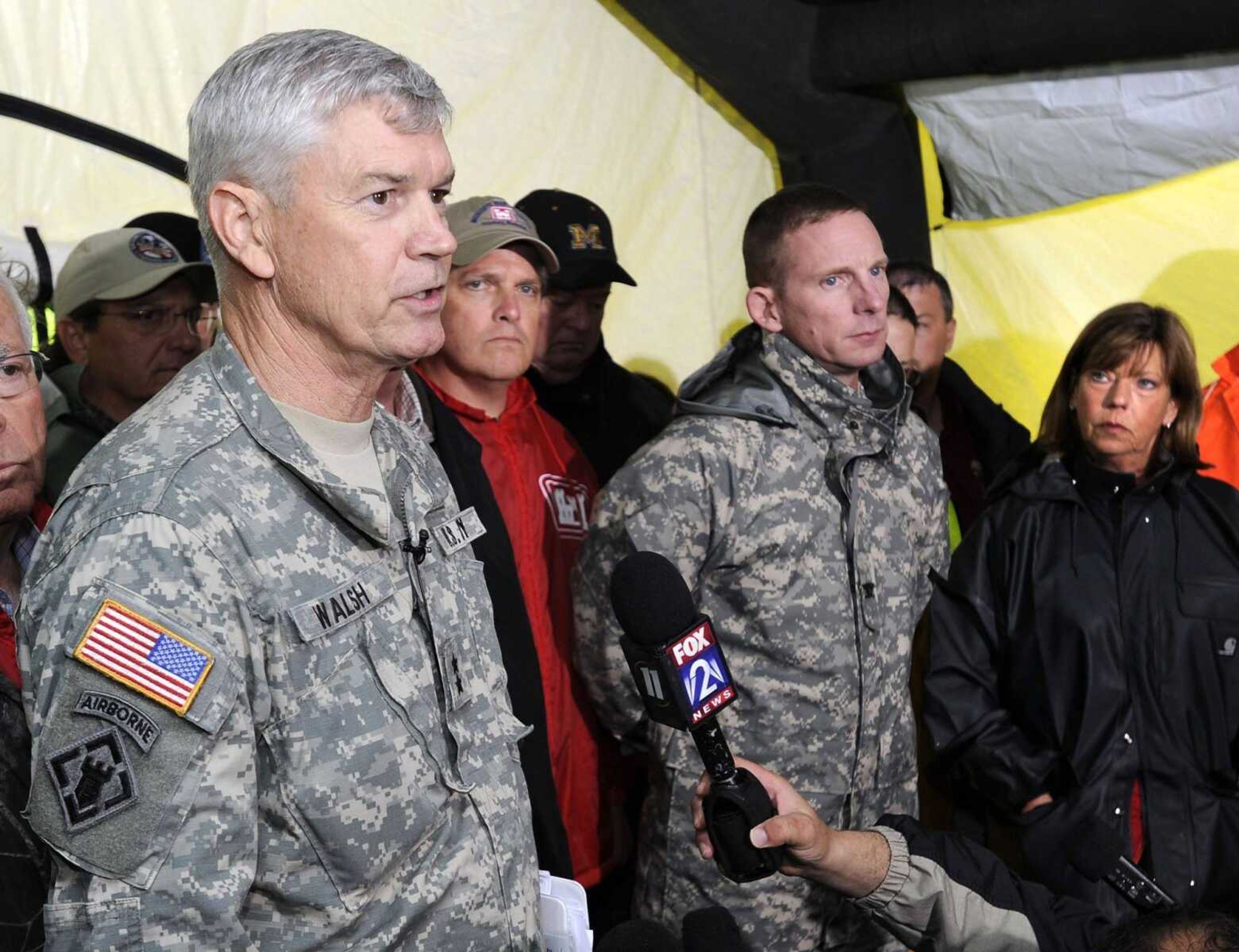Flood of 2011 anniversary: Corps maintains Birds Point levee breach saved billions in damages
Reservoirs were full, the rivers kept swelling and the rain kept coming. The Ohio River set a record of 61.1 feet on the Cairo, Ill., gauge. It was still climbing. Maj. Gen. Michael Walsh, president of the Mississippi River Commission, had a decision to make on May 1, 2011...
Reservoirs were full, the rivers kept swelling and the rain kept coming. The Ohio River set a record of 61.1 feet on the Cairo, Ill., gauge. It was still climbing.

Maj. Gen. Michael Walsh, president of the Mississippi River Commission, had a decision to make on May 1, 2011.
Under the Flood Control Act of 1928, The U.S. Army Corps of Engineers had the authority to intentionally breach the Birds Point levee and relieve pressure from the rising waters. His decision to act on this authority May 2 flooded 130,000 acres of farmland -- home to about 50 families in Mississippi and New Madrid counties.
It's a decision, according to the U.S. Army Corps of Engineers, that prevented more than $112 billion in damages throughout the Mississippi River and Tributaries system.
But the farmers, whose livelihood depends on the floodway, are still counting what Walsh's decision cost them. The Food and Agriculture Research Policy Institute estimates the crop losses alone at $85 million and a broader economic impact exceeding $156 million. Rep. Jo Ann Emerson contends the corps wasn't working off proper maps of the floodway and based its decision on incorrect hydrology.
A levee break in an unexpected area could have easily caused $1 billion in damage, said Robert Anderson, corps spokesman in Vicksburg, Miss.
"The entire system was at risk," Anderson said. "There were eminent failures. All along the system people were really at the point where the levees were about to be either overtopped or the pressure from the historic heights was just going to create a failure in an area that is not scheduled to fail."
An unplanned breach could have destroyed hundreds of homes, lives and cut off major transportation arteries, Anderson said.
The fact that the floodway plan had been in place for years didn't reduce the panic expressed during a town-hall meeting organized by Emerson on April 27 in East Prairie, Mo.
In the coming days, multiple times a day, Walsh and members of the Mississippi River Commission received updates on the capacity of Kentucky and Barkley lakes to hold back water, the condition of the levees, and the National Weather Service's latest forecasts.
Walsh waited as long as possible, longer than many of his colleagues thought he should have, to give the order to pump a slurry of explosives into pipes embedded in the Birds Point levee, according to a book the corps commissioned titled "Divine Providence -- History of the 2011 Flood" by Charles A. Camillo.
"Making this decision is not easy or hard," Walsh said. "It's simply grave -- because the decision leads to loss of property and livelihood, either in a floodway or in an area that was not designed to flood."
The operation, which cost about $2 million, was plagued with problems. The water was so high, just a foot or two below the top of the levee in places, that it made it difficult for crews to access. There was also lightning at the time. Then explosives ran short, forcing the corps to reduce the size of the first breach by 2,000 feet. When more explosives had to be obtained for the second breach site, these proved less effective, making a smaller hole in the levee than planned.
Engineers and planners are now working closely with the staff at the corps' Engineer Research and Development Center in Vicksburg to incorporate the lessons learned from last year's operation of the floodway into future plans, said Jim Pogue, spokesman for the Memphis District of the U.S. Army Corps of Engineers.
"This includes but is certainly not limited to the blasting agent we used and possible alternative blasting agents, and pipeline configuration," he said. "Our goal is to ensure we take full advantage of everything we learned last year so that any future floodway operation is done in the most efficient manner possible while providing the highest level of protection to the people of the region."
The corps is also working on a comprehensive report on its flood fighting efforts last year due out this August, Anderson said.
When asked if the breach at Birds Point could change the way the river is managed in the future, Anderson said it very well could.
The corps is looking at raising the levee in some areas, examining why the sand boils were so severe, and if there is a need for another floodway between Memphis and Vicksburg, he said.
This is the first time in history all three floodways in the Mississippi Rivers and Tributaries system were activated in the same flood event.
The last time the Birds Point levee was breached was in 1937 and since that time the floodway plan has been subject to scrutiny.
In 1987, the late congressman Bill Emerson pushed for a resolution to direct the corps to determine feasible alternatives to operating the floodway. As a result, a 1990 study looked at purchasing the land within the floodway, constructing permanent auxiliary channels in the floodway to confine floodwaters, realigning and setting back the front line levee at five locations to provide a wider floodplain and a plan of natural overtopping of the front-line levee. In the end, the study concluded that while several alternatives were feasible from an engineering standpoint, they were not justified economically.
In 1997, when the Cairo gauge reached 56 feet, the Mississippi River commission considered operating the floodway and went as far as loading barges with materials and equipment.
Rep. Jo Ann Emerson, Sen. Claire McCaskill and Sen Roy Blunt all say making sure the Birds Point levee is restored to its pre-flood height of 62.5 feet is a top priority. The corps has already spent $25 million on a temporary levee in place now at 55 feet, Anderson said. The entire Mississippi River and Tributaries system sustained more than $2 billion in damages from last year's flood.
Emerson has inserted language into the House Fiscal Year 2013 Energy and Water Appropriations bill requiring that these repairs be made by Dec. 31.
When it comes to future river management, Emerson said the local residents need to be part of the discussion.
"We have a lot of local stakeholders who know the lay of the land better than anybody else because they live and make their livelihood on it," she said. "The locals really need to be part of the solution."
Changing the way the activation of the floodway happens is not a matter of legislation, she said. It's the Mississippi River Commission's rule-making process that determined explosives should be used, not statute.
"It is very hard to get the corps of engineers to be what I consider forward thinking," Emerson said. "A better way of looking at it would be to have two or three alternatives to look at the precise moment when you have to make a decision," she said.
Emerson believes there are other ways to activate the floodway instead of using explosives.
Her preferred alternative would be to allow natural overtopping, which did occur in some places along the levee earlier in the day May 2. The corps didn't detonate the levee until later that night.
"I think they jumped the gun," she said.
mmiller@semissourian.com
388-3646
Connect with the Southeast Missourian Newsroom:
For corrections to this story or other insights for the editor, click here. To submit a letter to the editor, click here. To learn about the Southeast Missourian’s AI Policy, click here.










